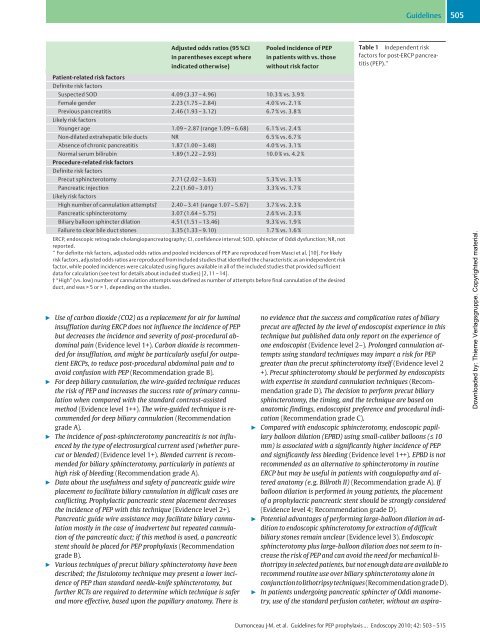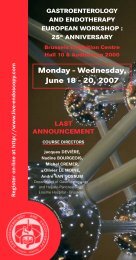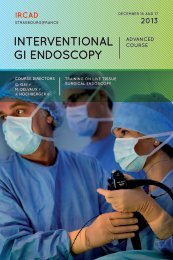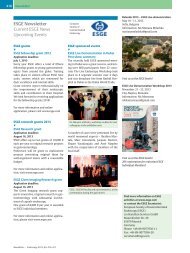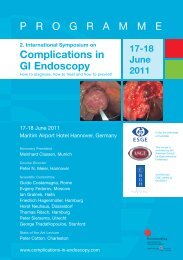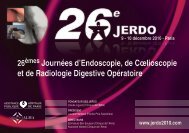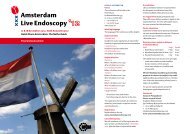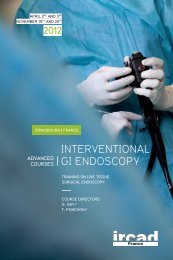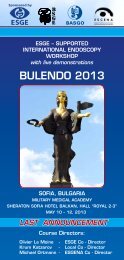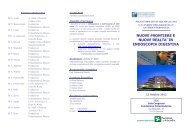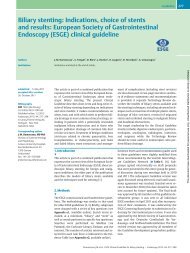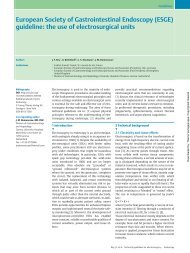(ESGE) Guideline: Prophylaxis of post-ERCP ... - ResearchGate
(ESGE) Guideline: Prophylaxis of post-ERCP ... - ResearchGate
(ESGE) Guideline: Prophylaxis of post-ERCP ... - ResearchGate
You also want an ePaper? Increase the reach of your titles
YUMPU automatically turns print PDFs into web optimized ePapers that Google loves.
Adjusted odds ratios (95%CI<br />
in parentheses except where<br />
indicated otherwise)<br />
" Use <strong>of</strong> carbon dioxide (CO2) as a replacement for air for luminal<br />
insufflation during <strong>ERCP</strong> does not influence the incidence <strong>of</strong> PEP<br />
but decreases the incidence and severity <strong>of</strong> <strong>post</strong>-procedural abdominal<br />
pain (Evidence level 1+). Carbon dioxide is recommended<br />
for insufflation, and might be particularly useful for outpatient<br />
<strong>ERCP</strong>s, to reduce <strong>post</strong>-procedural abdominal pain and to<br />
avoid confusion with PEP (Recommendation grade B).<br />
" For deep biliary cannulation, the wire-guided technique reduces<br />
the risk <strong>of</strong> PEP and increases the success rate <strong>of</strong> primary cannulation<br />
when compared with the standard contrast-assisted<br />
method (Evidence level 1++). The wire-guided technique is recommended<br />
for deep biliary cannulation (Recommendation<br />
grade A).<br />
" The incidence <strong>of</strong> <strong>post</strong>-sphincterotomy pancreatitis is not influenced<br />
by the type <strong>of</strong> electrosurgical current used (whether purecut<br />
or blended) (Evidence level 1+). Blended current is recommended<br />
for biliary sphincterotomy, particularly in patients at<br />
high risk <strong>of</strong> bleeding (Recommendation grade A).<br />
" Data about the usefulness and safety <strong>of</strong> pancreatic guide wire<br />
placement to facilitate biliary cannulation in difficult cases are<br />
conflicting. Prophylactic pancreatic stent placement decreases<br />
the incidence <strong>of</strong> PEP with this technique (Evidence level 2+).<br />
Pancreatic guide wire assistance may facilitate biliary cannulation<br />
mostly in the case <strong>of</strong> inadvertent but repeated cannulation<br />
<strong>of</strong> the pancreatic duct; if this method is used, a pancreatic<br />
stent should be placed for PEP prophylaxis (Recommendation<br />
grade B).<br />
" Various techniques <strong>of</strong> precut biliary sphincterotomy have been<br />
described; the fistulotomy technique may present a lower incidence<br />
<strong>of</strong> PEP than standard needle-knife sphincterotomy, but<br />
further RCTs are required to determine which technique is safer<br />
and more effective, based upon the papillary anatomy. There is<br />
Pooled incidence <strong>of</strong> PEP<br />
in patients with vs. those<br />
without risk factor<br />
Patient-related risk factors<br />
Definite risk factors<br />
Suspected SOD 4.09 (3.37 – 4.96) 10.3% vs. 3.9%<br />
Female gender 2.23 (1.75 – 2.84) 4.0% vs. 2.1%<br />
Previous pancreatitis<br />
Likely risk factors<br />
2.46 (1.93 – 3.12) 6.7% vs. 3.8%<br />
Younger age 1.09 – 2.87 (range 1.09– 6.68) 6.1 % vs. 2.4 %<br />
Non-dilated extrahepatic bile ducts NR 6.5 % vs. 6.7 %<br />
Absence <strong>of</strong> chronic pancreatitis 1.87 (1.00– 3.48) 4.0% vs. 3.1%<br />
Normal serum bilirubin<br />
Procedure-related risk factors<br />
Definite risk factors<br />
1.89 (1.22 – 2.93) 10.0% vs. 4.2%<br />
Precut sphincterotomy 2.71 (2.02 – 3.63) 5.3% vs. 3.1%<br />
Pancreatic injection<br />
Likely risk factors<br />
2.2 (1.60 – 3.01) 3.3 % vs. 1.7 %<br />
High number <strong>of</strong> cannulation attempts† 2.40 – 3.41 (range 1.07– 5.67) 3.7 % vs. 2.3 %<br />
Pancreatic sphincterotomy 3.07 (1.64 – 5.75) 2.6% vs. 2.3%<br />
Biliary balloon sphincter dilation 4.51 (1.51 – 13.46) 9.3 % vs. 1.9 %<br />
Failure to clear bile duct stones 3.35 (1.33– 9.10) 1.7% vs. 1.6%<br />
<strong>ERCP</strong>, endoscopic retrograde cholangiopancreatography; CI, confidence interval; SOD, sphincter <strong>of</strong> Oddi dysfunction; NR, not<br />
reported.<br />
* For definite risk factors, adjusted odds ratios and pooled incidences <strong>of</strong> PEP are reproduced from Masci et al. [10]. For likely<br />
risk factors, adjusted odds ratios are reproduced from included studies that identified the characteristic as an independent risk<br />
factor, while pooled incidences were calculated using figures available in all <strong>of</strong> the included studies that provided sufficient<br />
data for calculation (see text for details about included studies) [2,11 – 14].<br />
†“High” (vs. low) number <strong>of</strong> cannulation attempts was defined as number <strong>of</strong> attempts before final cannulation <strong>of</strong> the desired<br />
duct, and was > 5 or > 1, depending on the studies.<br />
<strong>Guideline</strong>s 505<br />
Table 1 Independent risk<br />
factors for <strong>post</strong>-<strong>ERCP</strong> pancreatitis<br />
(PEP).*<br />
no evidence that the success and complication rates <strong>of</strong> biliary<br />
precut are affected by the level <strong>of</strong> endoscopist experience in this<br />
technique but published data only report on the experience <strong>of</strong><br />
one endoscopist (Evidence level 2–). Prolonged cannulation attempts<br />
using standard techniques may impart a risk for PEP<br />
greater than the precut sphincterotomy itself (Evidence level 2<br />
+). Precut sphincterotomy should be performed by endoscopists<br />
with expertise in standard cannulation techniques (Recommendation<br />
grade D). The decision to perform precut biliary<br />
sphincterotomy, the timing, and the technique are based on<br />
anatomic findings, endoscopist preference and procedural indication<br />
(Recommendation grade C).<br />
" Compared with endoscopic sphincterotomy, endoscopic papillary<br />
balloon dilation (EPBD) using small-caliber balloons (≤ 10<br />
mm) is associated with a significantly higher incidence <strong>of</strong> PEP<br />
and significantly less bleeding (Evidence level 1++). EPBD is not<br />
recommended as an alternative to sphincterotomy in routine<br />
<strong>ERCP</strong> but may be useful in patients with coagulopathy and altered<br />
anatomy (e.g. Billroth II) (Recommendation grade A).If<br />
balloon dilation is performed in young patients, the placement<br />
<strong>of</strong> a prophylactic pancreatic stent should be strongly considered<br />
(Evidence level 4; Recommendation grade D).<br />
" Potential advantages <strong>of</strong> performing large-balloon dilation in addition<br />
to endoscopic sphincterotomy for extraction <strong>of</strong> difficult<br />
biliary stones remain unclear (Evidence level 3). Endoscopic<br />
sphincterotomy plus large-balloon dilation does not seem to increase<br />
the risk <strong>of</strong> PEP and can avoid the need for mechanical lithotripsy<br />
in selected patients, but not enough data are available to<br />
recommend routine use over biliary sphincterotomy alone in<br />
conjunctiontolithotripsytechniques(RecommendationgradeD).<br />
" In patients undergoing pancreatic sphincter <strong>of</strong> Oddi manometry,<br />
use <strong>of</strong> the standard perfusion catheter, without an aspira-<br />
Dumonceau J-M. et al. <strong>Guideline</strong>s for PEP prophylaxis … Endoscopy 2010; 42: 503 –515<br />
Downloaded by: Thieme Verlagsgruppe. Copyrighted material.


